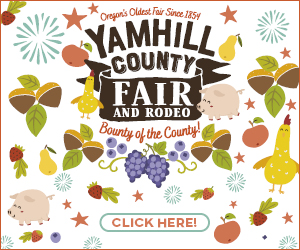Stopping By: Stitches in Time
“They call me the ‘label police lady,’” Hulett said, laughing at the gentle teasing of her fellow quilters.
Every quilt needs a label, she said. She’s adamant about that.
“Of course I label my own quilts!” she said. “My goal is that 100 years from now, people will know all about the quilts I do.”
Hulett has seen too many quilts without labels.
@@fast-facts@@
A frequent contributor to quilt-related programs staged by the Sheridan Historical Museum or Yamhill County Historical Society, she often runs into lovely textiles made in the 19th and 20th centuries. Some come with labels that tell her about the maker, the circumstances and the period of time, but many do not.
You can make educated guesses about fabrics and styles, Hulett said.
ALSO: Event will feature antique appraisals, quilts
But it would be so much better if the quilter had spent a few minutes labeling her creation. That’s information we need, she said.
Hulett, a Sheridan native, learned to sew as a child. She took home economics at Sheridan High School, honing her talents.
She would later return to Sheridan schools as a special education assistant, a job she held for more than 20 years. “All my life I’ve been a proud Spartan,” she said.
As a young mother, she sewed clothing for her five children — sons Mike, Pat and Ken, and daughters Debbi and Geri.
Later, she made her first quilt as a gift for her mother-in-law.
She’d seen the design in a magazine — a collection of handprints, made by tracing around various family members’ hands, then embroidering them onto a top piece of fabric, layered with fluffy batting and backing material, then stitched together.
Although she was pleased with the finished quilt, “I didn’t know what I was doing,” she admitted. If she were to do it again, she said, it would be more technically correct.
Later, when a cousin found a quilt top stitched together by her great-grandmother, Hulett finished it. She loves having something from her great-grandmother Brown’s own hand.
Hulett hand-quilted those early pieces, and many other quilts she made over the years. It involved hours of work, patiently anchoring the layers with needle and thread, one stitch at a time.
Nowadays, her hands no longer cooperate.
Instead, one of her fellow quilters does the job using a special sewing machine called a “long-arm quilter.” It can reach to the center of even a bed-size quilt.
She uses a sewing machine herself to piece together the sections of her quilts, whether they are hand- or machine-quilted. In fact, she’s now on her third Viking.
She keeps the second one at the site where one of her quilt clubs meets. The first one, she said, “I wore out completely.”
After finishing her first few quilts, Hulett was hooked. She’s since made quilts, all by hand, for each of her five children and 12 grandchildren.
Mostly, she said, “I made ones I liked and hoped they would, too.” But a few were tailored to their owners — an aquatic-themed quilt for Pat, a fisheries biologist, for example, and a penguin-themed one for Mike, who likes the flightless bird.
Selecting just the right fabric is sometimes difficult, Hulett said.
She often uses what she has on hand, pulling from a large stash she has stored according to color, pattern and fabric type. Occasionally she goes looking for new fabric to fit her plans.
She auditions the colors by placing them on her design wall — a board covered with flannel in a grid pattern.
The design wall and her fabric stash fill one wall of her quilting room, with the sewing machine and cutting table along the other. In one corner is a television set, a gift from her children.
“I can sew and watch Eleanor Burns or Alex Anderson,” she said, naming the hosts of two of her favorite quilting shows.
One of her favorite types of quiltmaking is working on “challenge quilts” with other members of one of her clubs, either the Coastal Hills Quilters, based in the West Valley, or the Piecemakers, based in McMinnville.
In a challenge, each member makes the same pattern or uses the same fabric. The resulting quilts vary widely, showing the different ways quilters interpreted the directions.
“It’s quite interesting to see,” she said.
In another kind of group quilting, each quilter makes several copies of one square. Then they trade, distributing the blocks so each person receives a stack of different squares to assemble into a quilt.
“It’s fun to know we all worked together on a project,” she said.
Hulett has one of those multi-maker quilts hanging over the back of her couch. When she flips over a corner, she sees the label she made. It tells her who created each section, the circumstances of the exchange, and the time period in which it was made.
In another room hangs a special memento from her days as president of the Piecemakers. Each member created a block featuring Hulett’s favorite color, purple, and a pattern called “Temple Court Blocks.”
She put them together and, of course, added a large label listing each block maker and where her block is located on the 2007 quilt.
“I love it!” she said. “The ladies made it special for me.”
In her living room, Hulett’s son affixed a sturdy curtain rod to the wall so she can suspend a changing display of quilts.
Currently featured is an equilateral triangle design that alternates triangles of white with those in several colors — including various shades of purple, of course.
She made the quilt from scraps dug out of her stash. “My goal was to use all my fabric up,” she said.
The quilt, with its dozens upon dozens of triangles, looks as if it were complicated to make. Not really, Hulett said.
She explained that she used a shortcut to make the triangles, which were later sewn together in an overall pattern.
First, she sewed together a long strip of white with a long strip of colored fabric. Then she cut the strip into equilateral triangles using a ruler and a rotary cutting tool — it’s quicker and more precise than scissors, as long as you “hold the ruler down tight when you’re cutting, so you don’t mess up.”
She’s a stickler for precision, but she’s really not that concerned with speed.
“I don’t pay any attention to the time it takes,” she said. “It doesn’t matter. It’s important to take your time and enjoy it.”
The length of time from picking fabric to finishing “just depends on how busy I am, and how intricate the pattern,” she said. And, of course, whether she has a deadline, such as an upcoming quilt show.
Hulett, who admits to having “too many unfinished projects,” sandwiches quilting in among numerous other activities. In addition to her work with the museum and historical society, she belongs to Sheridan Home Extension, the Sheridan Women’s Study Club and the two quilting clubs.
She’s busy with meetings in the early part of each month. Later in the month, she has more time to enjoy her favorite part of quilting: putting together small pieces to make something beautiful.
“These days, my goal is just to be able to make tops,” she said. “My kids can worry about getting them quilted.”
And labeled, of course.
Hulett especially likes old-fashioned patterns, such as blocks made from combinations of strips, squares, rectangles and triangles. Her favorites are anything that makes a star and log-cabin squares, where strips are stacked like the logs in a wall.
Her love of old patterns, combined with her interest in history, has made her “really fond of old, old quilts.”
And that’s led her to become adept at presentations called “bed turnings.” She’ll lead one twice during the “Treasures in the Attic” event, set for Saturday, Sept. 19, at the Yamhill Valley Heritage Center.
For a bed turning, 15 to 20 quilts are piled onto a bed, as if they’re there to cover a chilly sleeper on a really cold night. The narrator talks about the history of the top quilt as her assistants hold it up for an audience to see. Then the assistants fold the first quilt over the end of the bed and pick up the next one, while the presenter discusses its unique characteristics.
“Each quilt has a story,” Hulett said. They provide clues to how people lived, climate, travel and economic circumstances.
For instance, some quilters used feed or flour sacks either because that’s all they could afford or because they couldn’t get into town to buy new fabric. Other thrifty quilters sewed together scraps of old clothes, practicing recycling before it was the “in” thing.
Unfortunately, she can’t always tell the story completely. That’s because not every quilt has a label.
If they’re not labeled, she discusses as much as she can — the pattern, the way it’s made and quilted, the fabric, the colors.
“That’s as much as I can do,” she said. “But it’s not enough for me.”
Starla Pointer has been writing the weekly “Stopping By” column since 1996. Contact her at 503-687-1263 or spointer@newsregister.com.










Comments